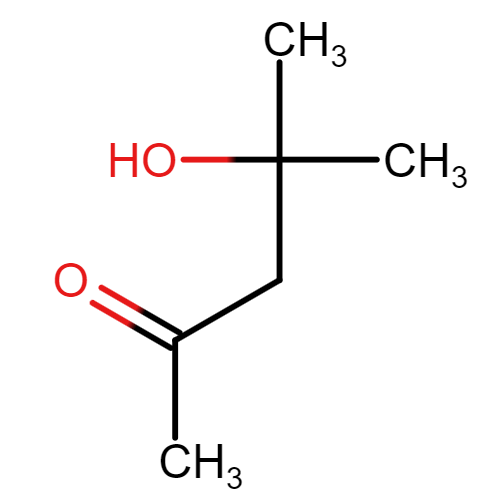4-hydroxy-4-methyl-2-pentanone
| Compound Structure: |

|
||||||||||||||||||||||||||||||||||||||||||||||||||
|---|---|---|---|---|---|---|---|---|---|---|---|---|---|---|---|---|---|---|---|---|---|---|---|---|---|---|---|---|---|---|---|---|---|---|---|---|---|---|---|---|---|---|---|---|---|---|---|---|---|---|---|
| Synonyms: | Diacetone alcohol; 4-HYDROXY-4-METHYL-2-PENTANONE;123-42-2;4-Hydroxy-4-methylpentan-2-one;Diacetonalkohol;Diketone alcohol;Diacetone;Pyranton;Tyranton; Acetonyldimethylcarbinol; Diacetone-alcool;Pyranton A | ||||||||||||||||||||||||||||||||||||||||||||||||||
| Compound ID: | NMPC-416 | ||||||||||||||||||||||||||||||||||||||||||||||||||
| PubChem ID: | |||||||||||||||||||||||||||||||||||||||||||||||||||
| Molecular Formula: | C6H12O2 | ||||||||||||||||||||||||||||||||||||||||||||||||||
| Canonical SMILES: | CC(=O)CC(C)(C)O | ||||||||||||||||||||||||||||||||||||||||||||||||||
| InChIKey: | SWXVUIWOUIDPGS-UHFFFAOYSA-N | ||||||||||||||||||||||||||||||||||||||||||||||||||
| About the compound: | Diacetone alcohol (DAA), a clear, scent-free chemical with the structure CH₃C(O)CH₂C(OH)(CH₃)₂, is notable for its utility both as a versatile synthetic intermediary in chemical synthesis and as a solvent for various uses[1]. It possesses a chemical composition of C₆H₁₂O₂ and a molecular weight of 116.160 g/mol, featuring moderate water solubility and compatibility with numerous organic solvents. DAA's physical characteristics include a low freezing point of −47°C, a boiling point of 166°C, and it is classified as flammable with a flash point of 52°C. Produced via the Ba(OH)₂-catalyzed joining of two acetone molecules, a process originally described by Heintz, DAA can be dehydrated to form mesityl oxide, a type of α,β-unsaturated ketone. Its hydrogenation results in hexylene glycol, and reacting DAA with urea creates a heterocyclic compound known as diacetone-monourea[1].DAA finds application in numerous fields, notably in the production of cellulose ester lacquers, where its absence of odor is particularly appreciated, and in thinners, dopes, wood stains, and wood preservatives. It is further utilized in the manufacture of synthetic silk and leather, celluloid cements, and in the composition of hydraulic brake fluids when blended with castor oil in equal parts[1]. Separately, the study of polyvinyl alcohol (PVA)-based solid polymer electrolytes (SPEs) is relevant to the development of renewable energy and advanced energy storage solutions. Supercapacitors, recognized for their broad application potential in devices such as electric vehicles, encounter energy storage limitations that PVA-based SPEs seek to overcome. By employing PVA as the foundational polymer, these SPEs have demonstrated capabilities to boost the electrochemical performance of energy storage systems through improved ionic conductivity[2]. References 1. Wikipedia contributors. "Diacetone Alcohol." Wikipedia, The Free Encyclopedia. https://en.wikipedia.org/w/index.php?title=Diacetone_alcohol&oldid=1153193835. 2. Danbature, W. L., Abdulkadir, B. A., et al. "A Review of Current Trends on Polyvinyl Alcohol (PVA)-Based Solid Polymer Electrolytes." Molecules 2023, 28(4), 1781. https://doi.org/10.3390/molecules28041781. GHS Hazard Statements • H319: Causes serious eye irritation [Warning Serious eye damage/eye irritation] |
||||||||||||||||||||||||||||||||||||||||||||||||||
| Properties: |
Chemical
and Physical Properties
Source: PubChem |
||||||||||||||||||||||||||||||||||||||||||||||||||
| Source Species: |
Artocarpus altilis. |